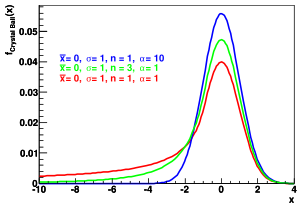Legendre's conjecture: Difference between revisions
en>Reddwarf2956 |
en>MFH added plot adopted from OEIS.org |
||
| Line 1: | Line 1: | ||
[[Image:CrystalBallFunction.svg|right|thumb|Examples of the Crystal Ball function.]] | |||
The '''Crystal Ball function''', named after the [[Crystal Ball (detector)|Crystal Ball]] Collaboration (hence the capitalized initial letters), is a [[probability density function]] commonly used to model various [[lossy process]]es in [[high-energy physics]]. It consists of a [[Gaussian function|Gaussian]] core portion and a [[power-law]] low-end tail, below a certain threshold. The function itself and its first [[derivative]] are both [[Continuous function|continuous]]. | |||
The Crystal Ball function is given by: | |||
:<math>f(x;\alpha,n,\bar x,\sigma) = N \cdot \begin{cases} \exp(- \frac{(x - \bar x)^2}{2 \sigma^2}), & \mbox{for }\frac{x - \bar x}{\sigma} > -\alpha \\ | |||
A \cdot (B - \frac{x - \bar x}{\sigma})^{-n}, & \mbox{for }\frac{x - \bar x}{\sigma} \leqslant -\alpha \end{cases}</math> | |||
where | |||
:<math>A = \left(\frac{n}{\left| \alpha \right|}\right)^n \cdot \exp\left(- \frac {\left| \alpha \right|^2}{2}\right)</math>, | |||
:<math>B = \frac{n}{\left| \alpha \right|} - \left| \alpha \right|</math>, | |||
:<math>N = \frac{1}{\sigma (C + D)}</math> | |||
:<math>C = \frac{n}{\left| \alpha \right|} \cdot \frac{1}{n-1} \cdot \exp\left(- \frac {\left| \alpha \right|^2}{2}\right)</math> | |||
:<math>D = \sqrt{\frac{\pi}{2}} \left(1 + \operatorname{erf}\left(\frac{\left| \alpha \right|}{\sqrt 2}\right)\right)</math> | |||
<math>N</math> (Skwarnicki 1986) is a normalization factor and <math>\alpha</math>, <math>n</math>, <math>\bar x</math> and <math>\sigma</math> are parameters which are fitted with the data. erf is the [[error function]]. | |||
==External links== | |||
* J. E. Gaiser, [http://www.slac.stanford.edu/cgi-wrap/getdoc/slac-r-255.pdf Appendix-F Charmonium Spectroscopy from Radiative Decays of the J/Psi and Psi-Prime, Ph.D. Thesis], SLAC-R-255 (1982). (This is a 205 page document in .pdf form – the function is defined on p. 178.) | |||
* M. J. Oreglia, [http://www.slac.stanford.edu/pubs/slacreports/slac-r-236.html A Study of the Reactions psi prime --> gamma gamma psi, Ph.D. Thesis], SLAC-R-236 (1980), Appendix D. | |||
* T. Skwarnicki, [http://inspirehep.net/record/230779/files/f31-86-02.pdf A study of the radiative CASCADE transitions between the Upsilon-Prime and Upsilon resonances, Ph.D Thesis], DESY F31-86-02(1986), Appendix E. | |||
{{ProbDistributions|continuous-infinite}} | |||
{{DEFAULTSORT:Crystal Ball Function}} | |||
[[Category:Probability distributions]] | |||
[[Category:Functions and mappings]] | |||
[[Category:Continuous distributions]] | |||
Revision as of 22:06, 5 May 2013

The Crystal Ball function, named after the Crystal Ball Collaboration (hence the capitalized initial letters), is a probability density function commonly used to model various lossy processes in high-energy physics. It consists of a Gaussian core portion and a power-law low-end tail, below a certain threshold. The function itself and its first derivative are both continuous.
The Crystal Ball function is given by:
where
(Skwarnicki 1986) is a normalization factor and , , and are parameters which are fitted with the data. erf is the error function.
External links
- J. E. Gaiser, Appendix-F Charmonium Spectroscopy from Radiative Decays of the J/Psi and Psi-Prime, Ph.D. Thesis, SLAC-R-255 (1982). (This is a 205 page document in .pdf form – the function is defined on p. 178.)
- M. J. Oreglia, A Study of the Reactions psi prime --> gamma gamma psi, Ph.D. Thesis, SLAC-R-236 (1980), Appendix D.
- T. Skwarnicki, A study of the radiative CASCADE transitions between the Upsilon-Prime and Upsilon resonances, Ph.D Thesis, DESY F31-86-02(1986), Appendix E.
55 yrs old Metal Polisher Records from Gypsumville, has interests which include owning an antique car, summoners war hack and spelunkering. Gets immense motivation from life by going to places such as Villa Adriana (Tivoli).
my web site - summoners war hack no survey ios










